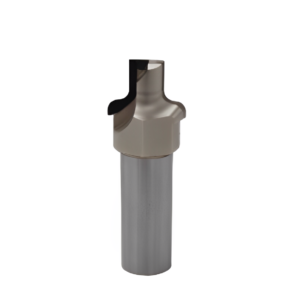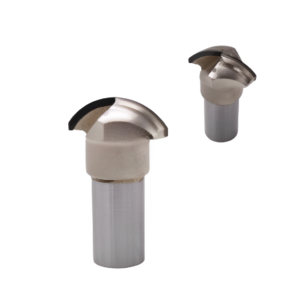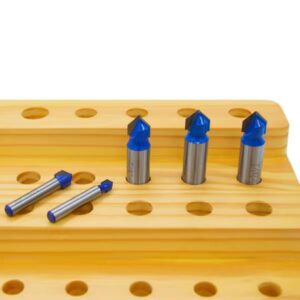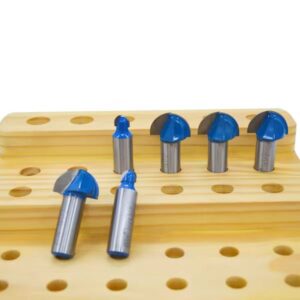Choisir le bon bit de routeur CNC est essentiel pour obtenir des résultats de haute qualité dans le travail du bois, travail métallique, ou fabrication de matériaux composites. Ce guide explore la géométrie, applications, et critères de sélection pour les bits de routeur CNC, Vous aider à prendre des décisions éclairées adaptées aux besoins de votre projet.
1. Flat End Router Bits
Conception & Functionality
Flat-end bits feature a flat cutting surface at the tip, making them ideal for cutting, fraisage, rainurage, and surface engraving. They produce clean, square-edged grooves and are available in two primary configurations:
– Straight Flute Bits: Best suited for woodworking, these bits remove material efficiently but generate more chip buildup. They excel in plunge cuts and are cost-effective for general-purpose tasks.
– Spiral Flute Bits: Designed for plastics, les métaux, and composites, spiral bits minimize heat buildup and reduce splintering. They come in three cutting styles:
– Up-Cut: Pulls chips upward, ideal for deep cuts in soft materials.
– Down-Cut: Pushes chips downward, ensuring a clean top surface for laminated materials.
– Compression Cut: Combines up-cut and down-cut spirals for clean edges on both sides of the workpiece (Par exemple, contre-plaqué).
Applications: Cabinet joinery, sign-making, and precision slotting.
2. Ball Nose Router Bits
Conception & Functionality
Characterized by a rounded tip, ball nose bits are engineered for 3D contouring, sculpting, and creating smooth curved surfaces. Their geometry distributes cutting forces evenly, reducing tool marks and enabling intricate detailing.
– Material Compatibility: While optimized for softwoods and plastics, carbide-tipped variants can handle hardwoods and non-ferrous metals.
– Tip Radius: Smaller radii (Par exemple, 1/16″) enable fine details, while larger radii (Par exemple, 1/2″) are better for sweeping curves.
Applications: 3D carvings, mold making, and decorative furniture elements.
3. V-Groove Router Bits
Conception & Functionality
V-groove bits feature a V-shaped cutting edge with angles ranging from 30° to 120°, allowing for precise engraving and decorative edge work.
– Small Angles (30°–60°): Perfect for detailed lettering, incrustations, and shallow grooves in hardwoods or acrylics.
– Large Angles (90°–120°): Create bold, wide grooves for signage, chamfering, or joining panels.
Applications: Custom signage, decorative trim, and joinery for picture frames.
4. Chamfer Router Bits
Conception & Functionality
Chamfer bits cut angled edges (bevels) for decorative or functional purposes. Equipped with guide bearings, they ensure consistent cutting depths.
– Common Angles: 11.25°, 15°, 22.5°, 30°, and 45°—selected based on project aesthetics or joint requirements.
– Plage de diamètre: From ⅛” for delicate edges to 2½” for heavy-duty applications.
Applications: Furniture edging (tabletops, étagères), multi-panel box construction, and easing sharp corners for safety.
5. Shaping & Molding Router Bits
These specialized bits create decorative profiles and functional joints. Key types include:
a. Roman Ogee Bits
– Profile: S-shaped curve for classical architectural detailing.
– Utiliser: Adding ornamental edges to furniture, armoires, or crown molding.
– Bearing Guide: Ensures stability during curved cuts.
b. Cove Router Bits
– Profile: Concave quarter-circle edge.
– Utiliser:
– Paired with round-over bits to create rule joints (Par exemple, drop-leaf tables).
– Decorative edges on frames, étagères, or window trims.
– Radius Options: 3/16″, 5/16″, etc., to match design requirements.
c. Round-Over Bits
– Profile: Convex quarter-circle edge for softening sharp corners.
– Utiliser: Enhancing safety and aesthetics on furniture edges (chaises, armoires).
– Adjustability: Interchangeable bearings control edge radius (Par exemple, 1/8″ to ½”).
Key Selection Criteria
1. Material Type: Match bit material (carbure, acier à haute vitesse) and coating to workpiece hardness.
2. Cut Depth & Speed: Optimize feed rates and RPM to prevent overheating.
3. Project Complexity: Use smaller bits for intricate designs and larger bits for bulk material removal.
4. Edge Quality: Down-cut spirals for laminated surfaces; compression cuts for plywood.
Conclusion
Understanding CNC router bit geometry empowers you to select tools that enhance precision, efficiency, and creativity. Whether crafting fine furniture or industrial components, the right bit ensures professional-grade results. Always prioritize quality—high-grade carbide bits may cost more upfront but deliver longevity and superior performance.




